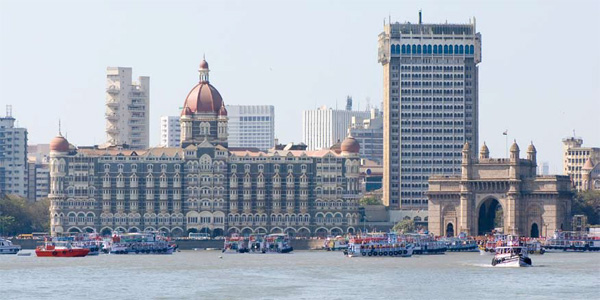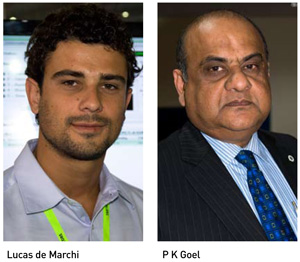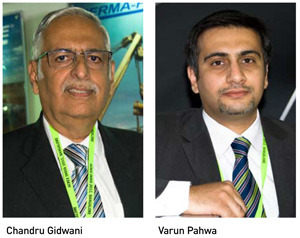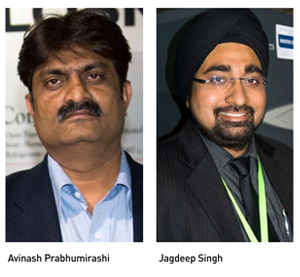India’s self-congratulatory triumphalism may have toned down in the wake of the recent economic drag. But HVACR players are vying for a place under its sun, which spells great opportunities for the sector.
India’s self-congratulatory triumphalism may have toned down in the wake of the recent economic drag. But HVACR players are vying for a place under its sun, which spells great opportunities for the sector. Story by Pratibha Umashankar (with inputs from B Surendar)

With the ominous news of the GDP pegged at an uninspiring 6.1% in the last quarter of 2011 – a three-year low – making headlines, India’s fiscal honeymoon seems to be over. But India continues to bask in its afterglow and appears to hold promise.
Foreign Direct Investment (FDI) especially in the food retail sector, with its attendant cold chain management, is the potential goldmine everyone is waiting to prospect, as against real estate development, which has lost its sheen, at least for now. Data centres and closed control cooling are the new buzzwords. Healthcare, pharma, hospitality and IT sectors are poised to be the frontrunners, with the manufacturing industry coming a close second.
It is this array of opportunities, both potential and real, which attracted participants to the 2012 edition of ACREX, the largest show in the country for air conditioning, refrigeration and allied building services, held in Bangalore, India from February 23 to 25.
P K Goel, General Manager (Marketing and Development in India) for Johnson Controls, present at the event, sums up the HVACR scenario in India: “Retail in India is definitely a new entrant. We see supermarkets, showrooms and shops. And it’s not just in Tier 1 cities but also in Tier 2 cities. We are also seeing investments in the hospitality industry, which includes medium-size hotels in suburbs. The next is healthcare. We have the ESIC (Employee State Insurance Corporation) hospitals, in the public sector. And in the private sector, you see new hospitals coming up and also renovation of existing facilities to meet global standards. The Ministry of Health in India has issued a notification that all health-related buildings have to be accredited and that all operating staff have to be trained and certified. And ISHRAE is launching a programme to get the training completed and the accreditation done.
 “In cities like Mumbai and Delhi, office space for IT is still being created. TCS and Infosys are expanding. So data centre jobs are being seen. Tata Telecom Services Limited (TTSL) has put up state-of-the-art technology using chilled beams to reduce airside power consumption and a combination of air-cooled and water-cooled chillers.
“In cities like Mumbai and Delhi, office space for IT is still being created. TCS and Infosys are expanding. So data centre jobs are being seen. Tata Telecom Services Limited (TTSL) has put up state-of-the-art technology using chilled beams to reduce airside power consumption and a combination of air-cooled and water-cooled chillers.
“Industrial expansion is also taking place. For instance, Ford is moving to Ahmedabad, and that might create substantial HVAC requirements. And on a pilot project basis, GIFT is planning to set up a cluster of buildings, which aim to meet green global standards and centralised chilled water facilities. The steel industry is on a major expansion, with news that almost 50 million tonnes of steel production might be added to the existing capacity in a short span of time. One, therefore, sees a lot of steel-related HVAC requirements, be they process-related cooling or controls.
“The Formula One event in Budh, in the central Indian state of Uttar Pradesh, was a feather in the cap for the HVAC industry, with controls and fire, safety and security systems installed to meet global standards. BMS (Building Management System) has almost become an integral part of large building developments and most hospitality and healthcare buildings are seen to install fire security systems.”
FDI – the tantalising low-hanging fruit
A recent UNCTAD survey projected India as the second most important FDI destination after China. Though telecommunication, construction and computer software and hardware are the big players, FDI in the retail sector holds the greatest potential. This is despite the fact that the unorganised retailing sector occupies an estimated 98%, while organised trade constitutes a mere two per cent. The Indian Government’s recent, if unadvised, hurry to welcome global retail giants into the closely guarded sector saw widespread protests, which forced it to put the idea in cold storage. But it is only a matter of time before the big players swamp the market, which is certain to have a cascading effect on the HVACR sector in the country, with an increase in demand for cold chain management.
“Wal-Mart is trying to penetrate the Indian market, and we do see an opportunity,” says Lucas de Marchi, who is with the export department of Brazilian company, Full Gauge Controls. “We’ll see a 20% to 30% increase in business,” says Deepak Malhotra, AVP (Operations) with the Air System Division of Fedders Lloyd Corporation Limited, optimistically. Goel concurs: “People who want to launch supermarket chains are gearing up in a big way to meet the requirements. And there are companies that look at cold chain developments of 500,000 square feet a month. This includes cold storages, ultra-low oxygen chambers, etc.”
Raghavan Ravi, Managing Director, Tecumseh Products India, Pvt Ltd, agrees that FDI in retail in India could give the much-needed boost to the industry, and explains where his company could step in: “I think 20% of perishable goods should be handled through a cold chain process. We, as a company, have solutions for mobile and stagnant cold rooms and compressor technology. We can work with parties directly involved in cold chain or get into cold chain.”
 Avinash Prabhumirashi, Senior Manager, Marketing, with Kirloskar, which is a big presence at the back-end of the cold chain process, stands the issue of cold chain on its head when he says: “As a business, our concern is with the large warehouses. Indeed, the back-end is the nature of our business. We are not into the front-end of the process. But we see the need for a strengthening of the links at the transport and intermediate storage level, and ultimately, at the front-end level, which is retail. Such a situation is desirable for us, because if all the links are strengthened the overall horticultural preservation will increase our business in refrigeration.”
Avinash Prabhumirashi, Senior Manager, Marketing, with Kirloskar, which is a big presence at the back-end of the cold chain process, stands the issue of cold chain on its head when he says: “As a business, our concern is with the large warehouses. Indeed, the back-end is the nature of our business. We are not into the front-end of the process. But we see the need for a strengthening of the links at the transport and intermediate storage level, and ultimately, at the front-end level, which is retail. Such a situation is desirable for us, because if all the links are strengthened the overall horticultural preservation will increase our business in refrigeration.”
Ramesh Paranjpe, independent refrigeration consultant, on the other hand, voices the concerns of Indian stakeholders. “When the cold chain concept comes, the Government of India should make it mandatory that at least 40% of the produce they (the international supermarket giants) buy should be from local growers,” he says. He introduces an interesting variable which could give a boost to other ancillary industries: “The National Horticulture Board is giving only subsidies for cold storage. But we are advocating the need for giving value addition for cold storage, like converting the produce to ready-to-eat products. Instead of throwing potatoes owing to excessive yield, we can make samosas and stuffed parathas, which can be frozen and sold. And export opportunities will open up.”
While Prabhumirashi believes that the powers that be will certainly open up FDI, “because food cold chain is the focus of the Government”, Ravi Sharma, Senior Manager (R&D) at ETA Engineering Private Limited, labels it “a politically driven agenda”, but hastens to add that FDI in the retail sector would be a positive move by the Government.
Even as the players in and outside the country eye the retail pie, Varun Pahwa of Bry-Air, sounds a caveat: “Europe wants more of the pie. They are all here for the long haul. But larger companies are probably thinking twice. There’s the inability of the central government to force things through in Parliament. Unless a clear government policy emerges, no one would make investments.”
However, there is agreement that with the growing Indian market, stricter controls and health inspections are bound to be enforced sooner or later. And this is where global players and local companies with world-class technology are ready to hit the ground running. Lucas de Marchi echoes this: “We realise there’s a market for a precise and reliable monitoring tool to take care of perishable goods and to ensure food safety. Currently, there’s no one giving the service, and we perceive an opportunity.”

Data centres – a window of opportunity
Data centres, with their need for server rooms, archive rooms, storage rooms, labs and closed control units, have witnessed an upswing after reaching a plateau stage. Alok Rajput of GEA, whose company showcased precision air conditioning units at Acrex, explains: “Overall, India is a growing market, because the government sector itself offers opportunities for business. As long as everything is going to be computerised, it requires data centres, and for that you do need closed control solutions.”
Jagdeep Singh, the COO and Director (Marketing) of Climaveneta, which has a large variety of precision cooling systems like DX, chilled water systems, free cooling and inverter cooling, does some number crunching: “In India, the bigger integrated data centres go for chilled water systems and smaller ones go for DX. Between Mumbai and Bangalore, the size of data centres is the largest in the world. The market size is about Rs 600 crores (USD 121 million approximately). This includes products, installation and maintenance. In addition to that, you have the market that can service the telecom sector – the largest in the world. In the last two years, due to the telecom scandal, a lot of projects were placed on the backburner. But next year, we can hope to see an explosion of growth. Also, small companies have set up their own data centres and require two to three closed control units each, and constitute 15% to 16% of the total market. And this will grow to 80% in India. We’ll witness a realignment and resurgence of the telecom sector. The total data centre market in India will be worth Rs 12,000 crores (USD 1.4 billion) by the end of 2012.”
However, Singh warns: “Everybody is trying to get a market share and, as a result, price levels have dropped to unsustainable levels. They are trying to make their money through AMCs. And that’s a problem we see. A leading air conditioning major in India made losses for the first time in 65 years, owing to cost cutting. Customers do want greater value for money and good quality, and hopefully this will change the situation.”
Pahwa, whose company, Bry-Air’s strategy of spreading out in product lines and regions has reportedly seen a healthy growth, reveals that India is into innovation and that it is finding global markets for its products. “A new product is our gas-phase filtration, which is essentially meant for data centres,” he says. “As a product coming out of India, it’s a game-changer. It has a new honeycomb filter, which blocks out sulphurs, chlorine, H2S and other sulphurs, which can cause havoc to computers. These gases are frequent culprits for the failure of IT equipment.
Caio Tadeu Brandao, Export Sales Manager of Duro-Dyne, acknowledging this new shift, says, “In India, they’re making products not only for the domestic market but also for export.”
The other frontrunners
Sudeep Sethi, of SPC (S&P Coil Product Limited), whose company started its operations in India four years ago in Delhi, Mumbai and Chennai, says that there is discernible growth in the hospitality sector, backed by a strong domestic demand, especially in the mid-level hotels. He explains: “This sector is growing, because India is developing Tier 2 cities to decongest the big metros. All these have – or are developing – international airports, and that means more hotels.”
With multi-specialty clinics, and as an offshoot of it, the pharma sector, has also witnessed growth. “Our equipment, like air purifiers and heat pumps, are perfect for the pharma industry,” says Sethi.
Malhotra, speaking for Lloyds, adds, “Our AHU systems have UV, VFD, heat-recovery wheel features, which are ideal for pharma, a sector which has picked up.”
AHUs – handle with care
 “It’s a slow market for HVAC in India,” is Ravi Sharma’s terse verdict. His company, ETA Engineering, has its own construction activities. “And that’s how we are surviving,” he admits, painting a grim picture, but adds, “The AHU market is very good and is picking up. But the standardised AHU market is very small here.”
“It’s a slow market for HVAC in India,” is Ravi Sharma’s terse verdict. His company, ETA Engineering, has its own construction activities. “And that’s how we are surviving,” he admits, painting a grim picture, but adds, “The AHU market is very good and is picking up. But the standardised AHU market is very small here.”
His concern, shared by others, is that there is stiff competition in the AHU segment for price, but not for quality. “People are not going for certification; the coils may be certified, but not the overall AHU,” Sharma points out. “Eurovent-type certification does not exist in India. ETA is the only company having Eurovent certification among AHU brands here.”
ETA, among others, hopes that the concept of energy labeling enforcement will eventually come to India. “Currently, the Bureau of Energy Efficiency labeling is only for residential units. What about commercial, which is a major chunk?” Sharma asks rhetorically.
Challenges
While everyone wants to script a part of India’s growth story, it’s the murky subplot they find hard to negotiate. Lack of standardisation in procedure and equipment; non-existent infrastructure, logistics and port congestion, which make movement of goods difficult; government agenda, which is sometimes at variance with the ground reality; saturation in certain sectors; slow growth; unstable market conditions; shrinking profit margins; and stalled developments due to cash flow crunch are few of the road blocks that hamper the sector.
But quality and pricing are the two most important hurdles that the HVACR sector faces in India say both new entrants and industry insiders.
Brandao of Duro-Dyne voices this: “You have a mix of standard and non-standard products. In prestigious developments, they ask for and make you follow standards and look at the certifications you have earned. But there are projects that look only at the price. For us, this can be a very good market if we can have a good mix of quality and pricing. Otherwise, we’ll not be able to compete with local players. But in mid-sized to large projects, where they look at certification, we can add quality and price.”
Brandao believes that commissioning is important from a building’s lifecycle point of view. “If the contractor has to replace faulty products once the building is in operation, it’ll increase costs two to three times,” he says. And for this, he wants ISHRAE (the Indian Society for Heating, Refrigerating and Air Conditioning Engineers) to take the lead and advocate commissioning standards in India.
Though ISHRAE is trying to push for a culture of commissioning, standardisation and better quality control, it still has a long way to go is the unanimous verdict.
In the case of cold chain, the challenges become even more nuanced, as the process in India is not organised and seamless. Spoilage due to bad handling and packaging, as also power and lack of basic infrastructure are areas where more could be done, given the geographical distances the goods have to travel. “There’s storage and cold chain infrastructure in retail, but the transport refrigeration link is weak,” says Ravi of Tecumseh. “The power and infrastructure situation won’t change so fast, and is especially a problem in rural and semi-urban areas.”
He believes that solar-powered refrigeration, which Tecumseh has, could be a solution. “There’s a lot of research happening, and ‘minus temperatures’ are being achieved for refrigeration that is solar driven,” adds Pankaj Dharkar of Pankaj Dharkar & Associates.
Conclusion
Looking at the litany of woes, one might be led to believe that the HVACR sector in India can be written off. But if the success of ACREX 2012, where exhibitors (and visitors) came in droves to exchange notes and showcase technologically innovative and environmentally sustainable products and services, was anything to go by, India is an exciting market to be in. But then, it’s a country of contradictions where both sides of a story are equally true.
India is in a hurry to shake off the tag of “developing” and enter the big league. But it has yet to get its act together. The industry, on its part, despite its many misgivings, wants a slice of the action. Meanwhile, the pretentious label of “India Inc” is fading, but firmly stuck. Squinting into the distance, Dharkar, whose optimism others would like to share, boldly prophesises: “The cold chain will change the prosperity of India.”
| DC a distant dream? |
| District cooling, which is no longer a novelty in the Middle East, is yet to strike roots in India. It’s still in its infancy and has a long way to go, say Pankaj Dharkar of Pankaj Dharkar & Associates and Chandru Gidwani of Perma-Pipe.However, “We have mixed developments happening in the country,” reveals Dharkar. “We are seeing a movement in that direction. A major district cooling plant is coming up in Gujarat (100,000 TR, going up to 300,000).”Adds Gidwani, “As a company, Perma-Pipe has installed the world’s longest heat-traced pre-insulated pipeline for the oil and gas industry – 610 kilometres from Barmar in Rajasthan to Salaya – and also a 150-kilometre-long pipeline,” says Gidwani. “Also, Perma-Pipe did the pre-insulated piping for chilling at the Budh Circuit for the F1 racing. This was a centralised cooling project, and Voltas gave us the job. We also did a project with TCS in Pune (in Western India) for an SEZ (Special Economic Zone).” He considers India a growing and steady market. “Property developers have visited us, and I can see awareness here on district cooling and for pre-insulated piping,” he says.Both Dharkar and Gidwani agree that district cooling is here to stay. However, Gidwani believes that the technology is flowing from the Middle East to India in this case. |
Copyright © 2006-2025 - CPI Industry. All rights reserved.